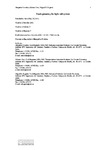Mostrar o rexistro simple do ítem
Track geometry for light rail systems
| dc.contributor.author | Novales, Margarita | |
| dc.contributor.author | Orro, Alfonso | |
| dc.contributor.author | Bugarín, M. R. | |
| dc.date.accessioned | 2023-01-09T16:20:00Z | |
| dc.date.available | 2023-01-09T16:20:00Z | |
| dc.date.issued | 2010 | |
| dc.identifier.citation | Novales, M., Orro, A., Bugarín, M. R. (2010). Track Geometry for Light Rail Systems. [Manuscrito aceptado] Transportation Research Record, 2146(1), 18–25. https://doi.org/10.3141/2146-03 | es_ES |
| dc.identifier.uri | http://hdl.handle.net/2183/32307 | |
| dc.description | Manuscrito aceptado para publicación (postprint) de: Novales, M., Orro, A., Bugarín, M. R. (2010). Track Geometry for Light Rail Systems. Transportation Research Record, 2146(1), 18–25. https://doi.org/10.3141/2146-03 | es_ES |
| dc.description.abstract | [Abstract:] As it is known, light rail systems are characterized by their running over the streets, with semi-exclusive (or “reserved”) right of way. This fact leads to the necessity of adapting the track geometry to the one existing in the streets, which sometimes leads to great challenges: strong vertical grades, horizontal circular curves with very small radius without superelevation and transition curves, vertical curves with very small minimum radius, etc. Nevertheless, there are several good reasons for limiting track geometry parameters as far as possible due to their influence in vehicles design, in the efforts that the vehicle will transmit to the track (and, therefore, in maintenance work) and in operational and construction costs of light rail systems. In the paper, limitations for different track geometry parameters will be analyzed, comparing recommended maximum or minimum values of each parameter established by TRB (Transportation Research Board) and by UITP (International Union of Public Transport) and explaining interesting cases, sometimes outside those limits. The main reasons for each limitation will be exposed, either related to vehicle design, or passenger comfort, or any other physical condition. Finally, the first conclusions of a research which is being developed by the authors in relation to track geometry parameters and construction costs of light rail systems in Spain will be presented. | es_ES |
| dc.language.iso | eng | es_ES |
| dc.publisher | Sage | es_ES |
| dc.relation.uri | https://doi.org/10.3141/2146-03 | es_ES |
| dc.rights | Atribución-NoComercial-SinDerivadas 3.0 España | es_ES |
| dc.rights.uri | http://creativecommons.org/licenses/by-nc-nd/3.0/es/ | * |
| dc.subject | Light-rail system | es_ES |
| dc.subject | Track geometry | es_ES |
| dc.subject | Vehicles design | es_ES |
| dc.subject | Construction costs | es_ES |
| dc.subject | TRB | es_ES |
| dc.subject | Transportation Research Board | es_ES |
| dc.subject | UITP | es_ES |
| dc.subject | International Union of Public Transport | es_ES |
| dc.title | Track geometry for light rail systems | es_ES |
| dc.type | info:eu-repo/semantics/article | es_ES |
| dc.rights.access | info:eu-repo/semantics/openAccess | es_ES |
| UDC.journalTitle | Transportation Research Record: Journal of the Transportation Research Board | es_ES |
| UDC.volume | 2146 | es_ES |
| UDC.issue | 1 | es_ES |
| UDC.startPage | 18 | es_ES |
| UDC.endPage | 25 | es_ES |
| dc.identifier.doi | 10.3141/2146-03 |
Ficheiros no ítem
Este ítem aparece na(s) seguinte(s) colección(s)
-
CITEEC-GFT - Artigos [21]






